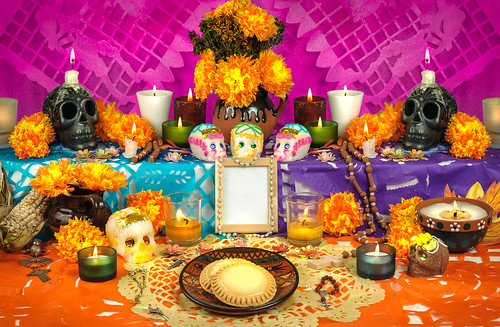We love Halloween so much that we hate when it’s over and we have to go back to our regular, non-spooky lives. Luckily, there are plenty of other festivals from around the world that we can celebrate while we wait for next October.
Samhain is sort of the grandfather of Halloween – it’s a Gaelic holiday with pre-Christian roots, and like so many other pagan holidays, when Christianity arrived, it just sort of got folded into the Christian calendar of events. While the midsummer festival (Beltane) was for the living, Samhain, on November 1, was when the doors to the spirit world opened and the dead came out to play. It’s been celebrated with bonfires, fortune-telling, and yes, even kids dressing up in costumes.
You’re probably already familiar with Día de Muertos, or Day of the Dead. This Mexican holiday goes from October 31 to November 2 (two extra days of skelton-y, ghost-y goodness!), but is often more somber than celebrations north of the border. The holiday is meant to celebrate the life of deceased family members, with the first day dedicated to children and the second to adults. The most common symbol used is a skull, with brightly colored ones used as decorations and various foods made in that shape.

Don’t let the bright colors fool you – Dia de Muertos is serious business.
Eid il-Burbara is celebrated amongst Middle Eastern Christians on December 4, and honors Saint Barbara. She was fleeing from Romans (who were persecuting her – this happened a lot to early Christians) and ran through a freshly planted wheat field. The wheat grew up behind her instantly, hiding her. As you can probably imagine, wheat is a big deal with this holiday, as are costumes – she’s said to have worn various disguises while on the run. Today, kids dress up and everyone eats Burbara, a dish made with boiled wheat, pomegranate seeds, raisins, and sugar. We wouldn’t blame them for maybe preferring a Snickers.
Related: The 13 Most Haunted Places in the World
China’s Hungry Ghost Festival, or Yu Lan Jie, falls on the fifteenth night of the Chinese calendar’s seventh month (next year it’s in August). Like Día de Muertos, it’s about veneration of deceased relatives and ancestors. The traditional belief holds that the borders between Heaven, Hell, and the realms of the living are open on this night, and various rituals are performed to ease the suffering of the dead. There are food offerings, along with elaborate meals served to the dead, and a common practice is floating paper boats and lanterns on the water to light the way of the spirits.

Joss paper is burned to provide material items to spirits in the afterlife.
In Japan, the Bon Festival is similar, though it lasts three days. Also held in the summer, it’s evolved into a family reunion of sorts, where people return to ancestral homes and honor ancestors by cleaning graves and visiting altars. Bonfires and traditional dances are also big parts of the festival, but the main reason for it is to care for the spirits of the dearly departed. Which sounds a lot nicer than messing around with a Ouija board, if you ask us.
How do you celebrate Halloween? Are you all about ceremonies and ancestral spirits, or just looking for some good scares? However (and whatever) you celebrate, have a happy Halloween!
About Meghan Brennan


